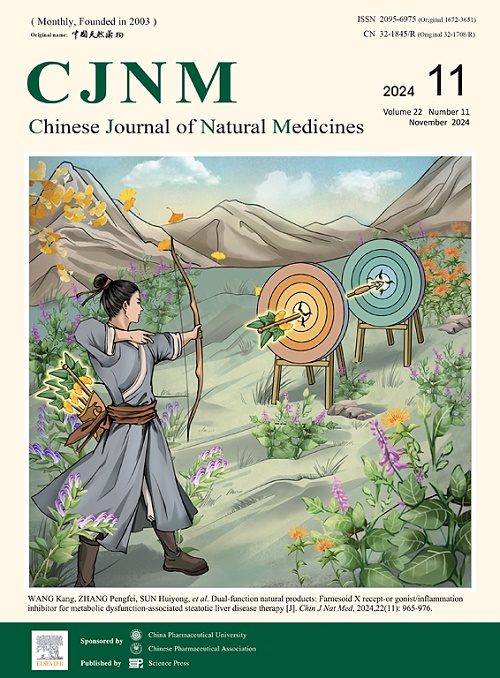天然存在的二环和非多环聚戊烯基酰基间苯三酚:分布、结构多样性和生物活性
IF 4.9
2区 医学
Q1 INTEGRATIVE & COMPLEMENTARY MEDICINE
引用次数: 0
摘要
多环聚戊烯酰化酰基间苯三酚(PPAPs)是一种独特的代谢物亚类,主要存在于植物界,特别是在木耳科(Clusiaceae)家族中。这些化合物具有显著的结构多样性和广泛的生物活性。Seco和non - ppap是ppap的两种独特变体,具有不同的骨骼结构,已被广泛研究。截至2023年6月,已从4个属中分离到200个化合物,其中金丝桃属为主要来源。值得注意的是,其中115种化合物是在过去四年中发现的,这表明研究活动显著增加。基于原始PPAP支架,Seco和non -PPAP可分为六个主要亚组。生物学研究已经揭示了它们在各种治疗应用中的潜力,包括抗癌、抗炎、保护肝脏、抗阿尔茨海默病(抗ad)、逆转多药耐药(MDR)、抗抑郁、神经保护和免疫抑制作用。本文综述了天然二、非PPAPs的发生、结构和生物活性,为PPAPs的进一步开发提供有价值的见解。本文章由计算机程序翻译,如有差异,请以英文原文为准。
Naturally occurring seco- and nor-polycyclic polyprenylated acylphloroglucinols: distribution, structural diversity, andbiological activity
Polycyclic polyprenylated acylphloroglucinols (PPAPs) represent a distinct subclass of specialized metabolites predominantly found in the plant kingdom, particularly within the Guttiferae (Clusiaceae) family. These compounds exhibit remarkable structural diversity and a wide range of biological activities. Seco- and nor-PPAPs, two unique variants of PPAPs with diverse skeletal structures, have been extensively investigated. As of June 2023, 200 compounds have been isolated from four genera, with Hypericum being the primary source. Notably, 115 of these compounds were identified in the past four years, indicating a significant increase in research activity. Seco- and nor-PPAPs can be categorized into six main subgroups based on the original PPAP scaffolds. Biological studies have revealed their potential in various therapeutic applications, including anti-cancer, anti-inflammatory, hepatoprotective, anti-Alzheimer's disease (anti-AD), multidrug resistance (MDR) reversal, anti-depressant, neuroprotective, and immunosuppressive effects. This review provides a comprehensive overview of the occurrence, structures, and bioactivities of natural seco- and nor-PPAPs, offering valuable insights for the further development of PPAPs.
求助全文
通过发布文献求助,成功后即可免费获取论文全文。
去求助
来源期刊

Chinese Journal of Natural Medicines
INTEGRATIVE & COMPLEMENTARY MEDICINE-PHARMACOLOGY & PHARMACY
CiteScore
7.50
自引率
4.30%
发文量
2235
期刊介绍:
The Chinese Journal of Natural Medicines (CJNM), founded and sponsored in May 2003 by China Pharmaceutical University and the Chinese Pharmaceutical Association, is devoted to communication among pharmaceutical and medical scientists interested in the advancement of Traditional Chinese Medicines (TCM). CJNM publishes articles relating to a broad spectrum of bioactive natural products, leading compounds and medicines derived from Traditional Chinese Medicines (TCM).
Topics covered by the journal are: Resources of Traditional Chinese Medicines; Interaction and complexity of prescription; Natural Products Chemistry (including structure modification, semi-and total synthesis, bio-transformation); Pharmacology of natural products and prescription (including pharmacokinetics and toxicology); Pharmaceutics and Analytical Methods of natural products.
 求助内容:
求助内容: 应助结果提醒方式:
应助结果提醒方式:


